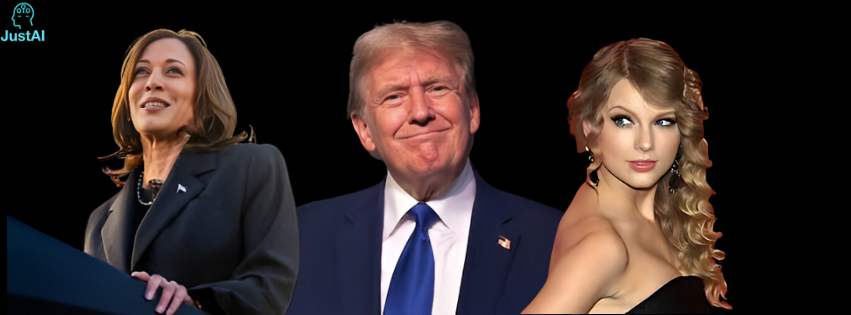Key highlights:
- AI and Election Integrity Concerns: The rise of AI-created misinformation raises critical questions concerning its potential threats to democratic processes and public trust and with such improvement of AI technology, it has the capability of creating misleading content and hence poses serious risks to the integrity of democratic processes.
- Trump posts deepfakes: Ex-President of the United States Donald Trump recently tweeted AI artworks on his Truth Social platform and these are of Taylor Swift in “Swifties for Trump” shirts, Kamala Harris at a communist parade that never took place, and Elon Musk.
- Blurred Lines Between Parody and Disinformation: Trump’s case showed deepfake pictures that hint at the ever-growing challenge of distinguishing between parody and real disinformation, where sometimes AI pictures can be so realistic that the public will mostly find it hard to distinguish between the truth and fiction.
As artificial intelligence further inserts itself into the political dialogue, former President Donald Trump’s most recent forays into AI-generated images have coursed with controversy and worry. In such recent sharing of deepfake images featuring Taylor Swift, Kamala Harris, and Elon Musk, Trump did not just push the boundaries of digital manipulation but opened a window onto surging challenges to distinguish between parody and genuine disinformation. The challenge that AI brings to the ability of influencing public opinion, consequently destabilizing democratic processes, becomes all the more acute as the technology evolves.
Deepfakes of Swift and Harris
The image of Swift shows her and her fans in T-shirts emblazoned with “Swifties for Trump,” but also includes an especially provocative one where she is dressed as Uncle Sam, urging people to vote for Trump. The depictions are not only wrongful but a total fabrication in the sense that Swift has never supported Trump and once criticized him.
Beyond the Swift imagery, Trump shared an AI-generated image of Kamala Harris attending a communist military rally as part of the Democratic National Convention. This image, combined with the deepfake video of Trump dancing with Elon Musk—an avowed supporter of his—provided a very clear example of how AI can be used in compiling riveting but misleading narratives and such exploitation of technology triggers many security concerns regarding its possible distortion of public perception and manipulation of voters.
AI and disinformation in the election process
It means that Trump using AI-generated content has dramatically highlighted a trend that is growing and worrisome in election misinformation. The better the technology, the more sophisticated the AI in creating highly realistic but wholly false content, which creates an environment, where telling the difference between real and fabricated becomes increasingly difficult. Some clear examples were images and videos posted by Trump, obviously showing how AI can be used to spread disinformation and create misleading endorsements or fake scenarios.
“Liar’s Dividend” and Media Credibility
Donald Trump’s recent activities also illustrate something called “liar’s dividend,” the idea that the proliferation of manipulated content could be what makes people skeptical about all media. When that much fake or misleading information is fabricated, this can cause people to question whether real media is actually authentic and in such a case, Trump is peddling false claims and manipulating images that facilitate, in a more general way, the dismantling of trust in the media, which makes it easier for people to turn away from real content branded as fake.
Musk’s Grok and the Evolution of AI Tools
The arrival of new AI tools has heaped further attention on AI-generated content. Grok, Elon Musk’s image generator, can cough up everything from the politically charged to controversy-laden images, creating an overload in deepfake material related to the election and that exposes the mega-challenge that lies in regulating AI technology and making sure it is used ethically, as the tool allows the creation of images which other AI models might refuse.
The fact that AI-generated imagery flourished immediately following the release of Grok underlines that development and fielding AI must be underpinned by strong safeguards and ethical considerations. Coupled with growing competence and accessibility, tackling potential applications of technologies manipulating the pipeline of truthful information is key to preserving the integrity of public discourse.
Historical Background: How AI Changed Political Campaigning
The debate raging over AI content is not a discrete one, but rather part of a larger, more inclusive historical setting as years earlier, AI-generated images and videos were already being deployed in political campaigns to influence public opinion. For example, during Ron DeSantis’s quest for the GOP nomination, his campaign posted an image that had been doctored to show Trump embracing Anthony Fauci and a similar charge was hurled at the Republican National Committee over a partially AI-generated attack ad against Joe Biden.
These historical examples demonstrate how AI content generation can be strategically applied to focus on political opponents, create misleading narratives, and shape voter perception and given that AI technology will only continue to improve, the potential impact it may have on political campaigns and public trust is of acute concern.
Conclusion
As AI-generated imagery is increasingly used in political campaigns, awareness and vigilance should be exercised in telling the genuine from the fabricated. Trump’s recent posts thus act as sharp reminders of the many challenges that AI technology will bring forth in maintaining the integrity of public discourse, where in light of the rapid growth in AI, it becomes important to equip oneself with effective strategies in areas of media literacy and regulatory measures against misinformation in order to safeguard democratic procedures and bring about a very transparent and informed electoral environment.
References
https://www.nytimes.com/2023/06/08/us/politics/desantis-deepfakes-trump-fauci.html
https://www.theguardian.com/us-news/article/2024/aug/19/trump-ai-swift-harris-musk-deepfake-images
https://news.sky.com/story/donald-trump-posts-fake-images-of-taylor-swift-endorsement-13200068

